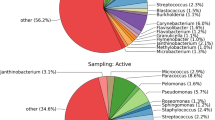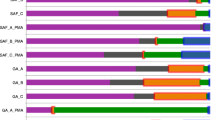Abstract
Metagenomics is a novel genomic tool employed to accurately study the composition of microbial communities in their ecological environments, including mass transport systems. Despite the potential significance of these sites as sources of exposure, the pathogenic microbiomes in these constructed settings remain unexplored. In this study, high-throughput sequencing was utilized to identify the microbiota obtained from the Metropolitan Transport of Shanghai (MTS) during the spring and summer. A diverse range of microbiota, especially pathogens, and models for mapping diversity and environmental variables were analyzed using the metagenomic techniques. The results indicate that bacteria accounted for 95.26% of the categorized genes in the 108 aerosol samples analyzed during the spring and summer, with the remaining 4.73% attributed to eukaryotes, viruses, and archaea. We successfully identified 86 microorganisms that align with the National Microbiology Data Center's List of Pathogenic Microorganisms, uncovering unique characteristics of various species with potential health implications throughout across seasons. Additionally, the distribution and diversity of the microbiota were significantly influenced by temperature, humidity, season, and time of day. The study's findings establish a framework for investigating and evaluating potential public health risks, offering early warning of biosecurity concerns related to these built environments. They also provide a comprehensive and unbiased perspective on the characteristics of microbial communities and potential pathogens in urban metros. Environmental and public health experts will find this investigation into the pathogenic microbiomes found in aerosol samples compelling.








Similar content being viewed by others
Data availability
All raw sequence data generated by this study have been made available in the NCBI Sequence Read Archive under BioProject PRJNA934719. Metadata are also stored in the SRA BioProject PRJNA934719. The high-quality Figures are available via the Figshare repository, https://doi.org/10.6084/m9.figshare.22566736.
References
Afshinnekoo E, Meydan C, Chowdhury S et al (2015) Geospatial Resolution of Human and Bacterial Diversity with City-Scale Metagenomics. Cell Syst 1(1):97-97.e3
Bahram M, Hildebrand F, Forslund SK et al (2018) Structure and function of the global topsoil microbiome. Nature 560(7717):233–237
Baik K, Park S, Kim E et al (2008) Diversity of bacterial community in freshwater of Woopo wetland. J Microbiol 6(46):647–655
Bockwoldt JA, Zimmermann M, Tiso T et al (2020) Complete Genome Sequence and Annotation of the Paracoccus pantotrophus Type Strain DSM 2944. Microbiol. Resour. Announc. 9(1). https://doi.org/10.1128/MRA.01290-19
Bradley PH et al (2017) Proteobacteria explain significant functional variability in the human gut microbiome. Microbiome 5(1):36. https://doi.org/10.1186/s40168-017-0244-z
Bruno A, Fumagalli S, Ghisleni G et al (2022) The Microbiome of the Built Environment: The Nexus for Urban Regeneration for the Cities of Tomorrow. Microorganisms 10(12):2311–2311
Chakrawarti MK, Singh M, Yadav VP et al (2020) Temporal Dynamics of Air Bacterial Communities in a University Health Centre Using Illumina MiSeq Sequencing. Aerosol Air Qual Res 20(5):966–980
China National Accreditation Service (2008) General Laboratory Biosafety Requirements. http://www.cebsit.cas.cn/ggpt/ggjsfwzx/gzzd/201907/P020190703347767043754.pdf. Accessed 10 Mar 2023
Danko D, Bezdan D, Afshinnekoo E et al (2020) Global Genetic Cartography of Urban Metagenomes and Anti-Microbial Resistance. BioRxiv. https://doi.org/10.1101/724526
Denning DW, O’Driscoll BR, Hogaboam CM et al (2006) The link between fungi and severe asthma: a summary of the evidence. Eur Respir J 27(3):615–626
Dréno B, Pécastaings S, Corvec S et al (2018) Cutibacterium acnes (Propionibacterium acnes) and acne vulgaris: a brief look at the latest updates. J Eur Acad Dermatol Venereol 32(Suppl):25–14. https://doi.org/10.1111/jdv.15043
Fernandez-Iriarte A, Duchaine C, Degois J et al (2021) Bioaerosols in public and tourist buses. Aerobiologia 3(37):525–541
Findley K, Oh J, Yang J et al (2013) Topographic diversity of fungal and bacterial communities in human skin. Nature 498(7454):367–370
Fu LM, Niu BF, Zhu ZW et al (2012) CD-HIT: accelerated for clustering the next-generation sequencing data. Bioinformatics 23(28):3150–3152
Gohli J, Boifot KO, Moen LV et al (2019) The subway microbiome: seasonal dynamics and direct comparison of air and surface bacterial communities. Microbiome 7(1). https://doi.org/10.1186/s40168-019-0772-9
Grice EA, Kong HH, Conlan S et al (2009) Topographical and temporal diversity of the human skin microbiome. Science 324:1190–1192
Hannigan G et al (2013) Microbial ecology of the skin in the era of metagenomics and molecular microbiology.Cold Spring Harb. Perspect. Med. 3(12):a015362. https://doi.org/10.1101/cshperspect.a015362
Harding CM, Hennon SW, Feldman MF et al (2018) Uncovering the mechanisms of Acinetobacter baumannii virulence. Nat Rev Microbiol 16(2):91–102
He MQ, Zhao RL, Hyde KD et al (2019) Notes, outline and divergence times of Basidiomycota. Fungal Divers 99(1):105–367
Huber W, Carey VJ, Gentleman R et al (2015) Orchestrating high-throughput genomic analysis with Bioconductor. Nat Methods 2(12):115–121
Innocente E, Squizzato S, Visin F et al (2017) Influence of seasonality, air mass origin and particulate matter chemical composition on airborne bacterial community structure in the Po Valley, Italy. Sci Total Environ 593–687. https://doi.org/10.1016/j.scitotenv.2017.03.199
Jeon YJ, Zhou YL, Li YH et al (2017) The feasibility study of non-invasive fetal trisomy 18 and 21 detection with semiconductor sequencing platform. PLoS ONE 9(10):e110240–e110240
Karanasiou AV, Mar Q et al (2014) Assessment of personal exposure to particulate air pollution during commuting in European cities-Recommendations and policy implications. Sci Total Environ 490:785–797
Kawulok J, Kawulok M, Deorowicz S et al (2019) Environmental metagenome classification for constructing a microbiome fingerprint. Biol Direct 14(1):20. https://doi.org/10.1186/s13062-019-0251-z
Kwak MK, Liu R, Kwon JO et al (2013) Cyclic dipeptides from lactic acid bacteria inhibit proliferation of the influenza a virus. J Microbiol 6(51):834–843
Lee SD, Lee DW (2009) Scopulibacillus darangshiensis gen. nov., sp. nov., isolated from rock. J Microbiol 47:710–715. https://doi.org/10.1007/s12275-009-0111-0
Legendre P et al (2014) Interpreting the replacement and richness difference components of beta diversity. GLOBAL ECOL BIOGEOGR 23(11):1324–1334
Leung MHY, Tong X, Boifot KO et al (2021) Characterization of the public transit air microbiome and resistome reveals geographical specificity. Microbiome 9(1):112–112
Li JH, Jia HJ, Cai XH et al (2014) An integrated catalog of reference genes in the human gut microbiome. Nat Biotechnol 8(32):834–841
Liu Q, Roh JY, Wang Y et al (2012) Construction and Characterisation of an Antifungal Recombinant Bacillus thuringiensis with an Expanded Host Spectrum. J Microbiol 3(50):874–877
Long Y, Zhang YX, Gong YP et al (2016) Diagnosis of Sepsis with Cell-free DNA by Next-Generation Sequencing Technology in ICU Patients. Arch Med Res 5(47):365–371
Luo RB, Liu BH, Xie YL et al (2012) SOAPdenovo2: an empirically improved memory-efficient short-read de novo assembler GIGASCIENCE 1(1):18. https://doi.org/10.1186/2047-217x-1-18
Manuel DB, Angela MO, Tess EB et al (2018) A global atlas of the dominant bacteria found in soil. Science 359(6373):320–325. https://doi.org/10.1126/science.aap9516
McMurdie PJ et al (2013) phyloseq: An R Package for Reproducible Interactive Analysis and Graphics of Microbiome Census Data. PLoS ONE 4(8):e61217. https://doi.org/10.1371/journal.pone.0061217
Meadow JF, AE Altrichter et al (2015). Humans differ in their personal microbial cloud. PeerJ 3e1258. https://doi.org/10.7717/peerj.1258
Meehan CJ, Goig GA, Kohl TA et al (2019) Whole genome sequencing of Mycobacterium tuberculosis: current standards and open issues. Nat Rev Microbiol 17(9):533–545
Metagenomics & Metadesign of Subways & Urban Biomes. http://metasub.org/. Accessed 10 Mar 2023
MicrobeWiki. https://microbewiki.kenyon.edu/index.php/MicrobeWiki. Accessed 10 Mar 2023
National Microbiology Data Center. https://nmdc.cn/. Accessed 10 Mar 2023
Nguyen MT et al (2016) Lipoproteins of Gram-Positive Bacteria: Key Players in the Immune Response and Virulence. Microbiol Mol Biol Rev 3(80):891–903
Nowakowicz-Debek B, Pawlak H, Wlazlo L et al (2017) Evaluating bioaerosol exposure among bus drivers in the public transport sector. J Occup Environ Hyg 14(11):169–172
O’Hara NB, Reed HJ, Afshinnekoo E et al (2017) Metagenomic characterization of ambulances across the USA. Microbiome 5(1):125. https://doi.org/10.1186/s40168-017-0339-6
Orlova EA, Ogarkov OB, Suzdalnitskiy AE et al (2021) Analysis of Microbial Diversity in Caseous Necrosis of Tuberculosis Foci. Mol Genet Microbiol 36(3):132–138
Parte AC, Carbasse JS, Meier KJP et al (2020) List of Prokaryotic names with Standing in Nomenclature (LPSN) moves to the DSMZ. Int J Syst Evol Micr 11(70):5607–5612
Peimbert M (2022) Where environmental microbiome meets its host: Subway and passenger microbiome relationships. Mol. Ecol 32(10). https://doi.org/10.1111/mec.16440
Peleg AY, Hogan DA, Mylonakis E et al (2010) Medically important bacterial-fungal interactions. Nat Rev Microbiol 8(5):340–349
Priyamvada H, Ravikrishna R, Gunthe SS et al (2018) Assessment of PM and bioaerosols at diverse indoor environments in a southern tropical Indian region. Build Environ 137215–225. https://doi.org/10.1016/j.buildenv.2018.04.016
Rosenthal M, Goldberg D, Aiello A et al (2011) Skin microbiota: microbial community structure and its potential association with health and disease. Infect Genet Evol 11:839–848
Salvaraji L, Shamsudin SB, Avoi R et al (2022) Ecological Study of Sick Building Syndrome among Healthcare Workers at Johor Primary Care Facilities. IJERPH 19(24):17099–17099. https://doi.org/10.3390/IJERPH192417099
Shanghai metro database. https://metrodb.org/index/shanghai.html. Accessed 10 Mar 2023
Sharma D, Misba L, Khan AU et al (2019) Antibiotics versus biofilm: an emerging battleground in microbial communities. Antimicrob Resist Infect Control 8(1):1–10
Sowiak M, Kozajda A, Jezak K et al (2018) Does the air condition system in busses spread allergic fungi into driver space? Environ Sci Pollut Res 25(5):5013–5023
Sun Y, Fu X, Li YL et al (2020) Shotgun metagenomics of dust microbiome from flight deck and cabin in civil aviation aircraft. Indoor Air 30(6):1199–1212
Tignat-Perrier R, Dommergue A, Thollot A et al (2020) Seasonal shift in airborne microbial communities. Sci Total Environ. 716(C):137129. https://doi.org/10.1016/j.scitotenv.2020.137129
Truong DT, Franzosa EA, Tickle TL et al (2015) MetaPhlAn2 for enhanced metagenomic taxonomic profiling. Nat Methods 10(12):902–903
Union Internationale des Transports Publics (2023). https://www.uitp.org/. Accessed 10 Mar 2023
Villanueva RAM, Chen ZJ (2019) ggplot2: elegant graphics for data analysis, 2nd ed. Measure Interdisciplin Res Perspect 17(3):160–167. https://doi.org/10.1080/15366367.2019.1565254
Wang CY et al (2016) Study on the real state of microbial contamination and heat and humidity response of air conditioning units. M.S. thesis, Dept, Architecture and Engineering, Dalian University of Technology, Dalian, China
WHO. WHO releases first-ever list of health-threatening fungi. (2022) Last accessed: Mar, 10, 2023, https://www.who.int/news/item/25-10-2022-who-releases-first-ever-list-of-health-threatening-fungi
Wu J, Danko D, Afshinnekoo E et al (2022) Annotating unknown species of urban microorganisms on a global scale unveils novel functional diversity and local environment association. Environ Res 207112183–112183. https://doi.org/10.1016/j.envres.2021.112183
Zhang RZ, Walker AR, Datta S et al (2021) Unraveling city-specific signature and identifying sample origin locations for the data from CAMDA MetaSUB challenge. Biol Direct 16(1):1–1
Zheng Y, Hunt RL, Villaruz AE et al (2022) Commensal Staphylococcus epidermidis contributes to skin barrier homeostasis ceramides. Cell Host Microbe 30(3):301-313.e9
Zhu CS, Miller M, Nick L et al (2019) Fingerprinting cities: differentiating subway microbiome functionality. Biol Direct 14(1):1–1
Zhu WH, Lomsadze A, Borodovsky M et al (2010) Ab initio gene identification in metagenomic sequences. NAR 12(38):e32. https://doi.org/10.1093/nar/gkq275
Funding
The authors gratefully thank the Foundation of Shanghai Municipal Health commission (Grant number:202240327 and 202040185) and Shanghai 3-year Public Health Action Plan (Grant number: GWVI-11.1–39), the Fudan university and Shanghai Municipal Center for Disease Control and Prevention for financial support and Genomics(www.genomics.cn) for sequencing analysis.
Author information
Authors and Affiliations
Corresponding authors
Ethics declarations
Ethics approval and consent to participate
Not applicable.
Consent for publication
The author confirms:
•That the work described has not been published before (except in the form of an abstract or as part of a published lecture, review or article );
•That it is not under consideration for publication elsewhere;
•That its publication has been approved by all co-authors, if any;
•That its publication has been approved by the reasonable authorities at the institution where the work is carried out.
Competing interests
The authors declare that they have no known competing financial interests or personal relationships that could have appeared to influence the work reported in this paper.
Additional information
Publisher's Note
Springer Nature remains neutral with regard to jurisdictional claims in published maps and institutional affiliations.
Rights and permissions
Springer Nature or its licensor (e.g. a society or other partner) holds exclusive rights to this article under a publishing agreement with the author(s) or other rightsholder(s); author self-archiving of the accepted manuscript version of this article is solely governed by the terms of such publishing agreement and applicable law.
About this article
Cite this article
Liu, Y., Zhang, L., Wang, D. et al. Characterization of microbial communities in urban subway: connotation for indoor environment quality and public health. Air Qual Atmos Health (2024). https://doi.org/10.1007/s11869-024-01515-4
Received:
Accepted:
Published:
DOI: https://doi.org/10.1007/s11869-024-01515-4




